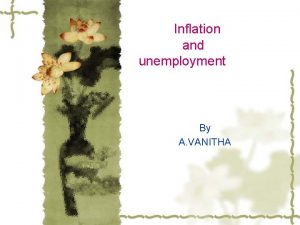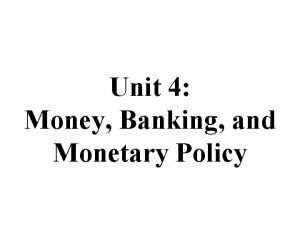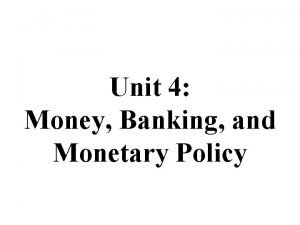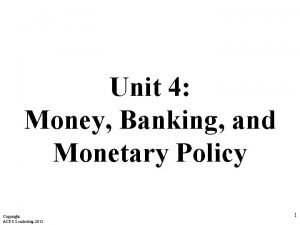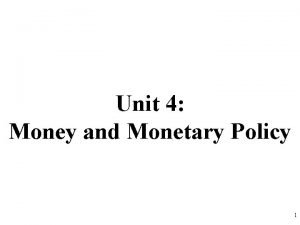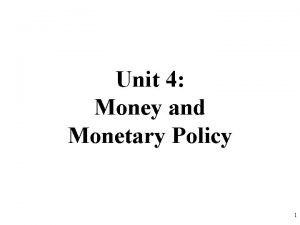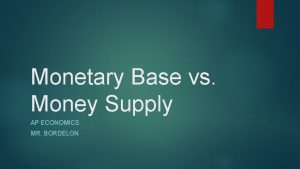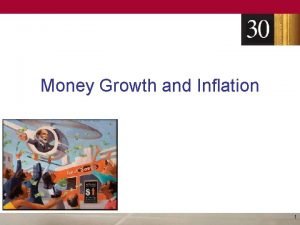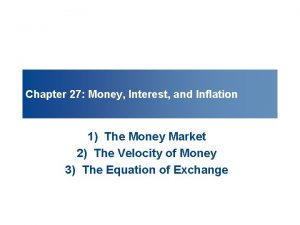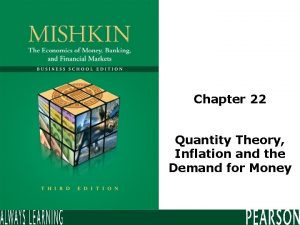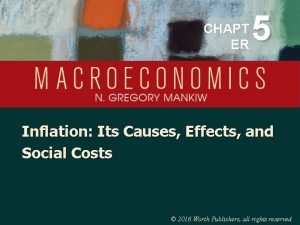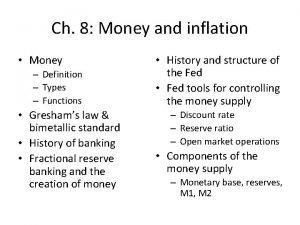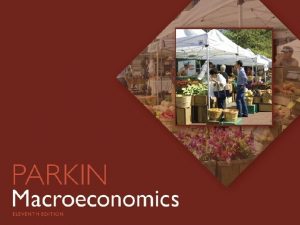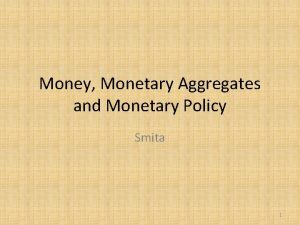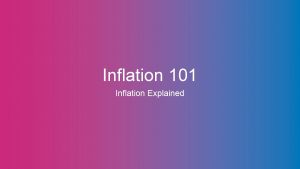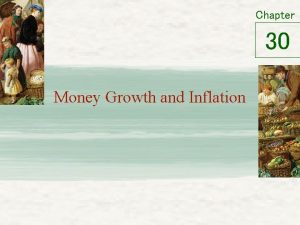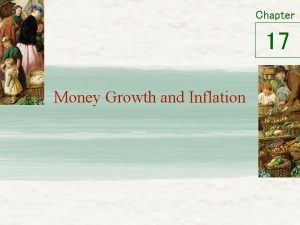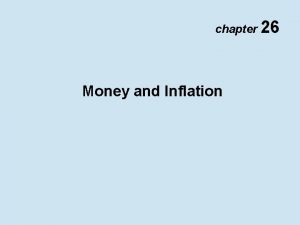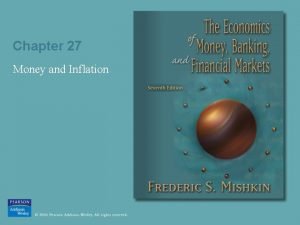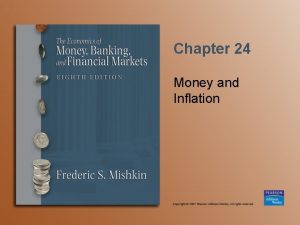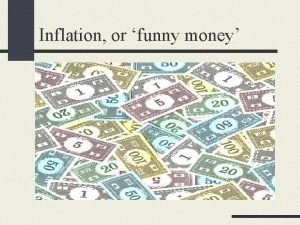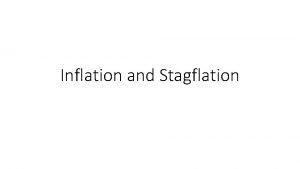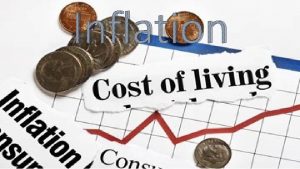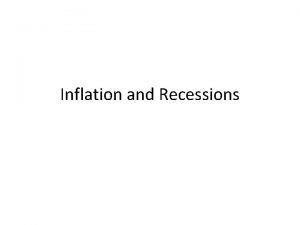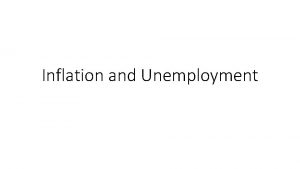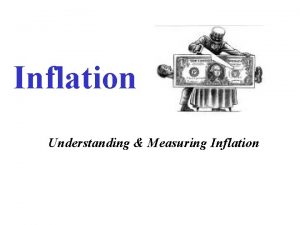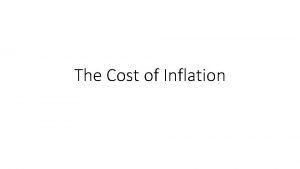Money and Credit Lecture 9 Inflation and monetary



















- Slides: 19

Money and Credit Lecture 9 Inflation and monetary reforms

Content 1. Classification of monetary reforms 2. Models of monetary reforms 3. Monetary Reform in Ukraine (2 -16 September 1996) 4. Essence, types and patterns of inflation 4. 1. The theoretical concept of inflation 4. 2. Peculiarities of the inflationary process 4. 3. The essence and definition of inflation 4. 4. Measurement of inflation 4. 5. Types of inflation 4. 6. Consequences of inflation

Main definitions: o inflation o monetary reform o currency stabilization o creeping inflation o Hyperinflation o devaluation o revaluation o nullification o …………. .

1. Classification of monetary reforms Monetary reform - a complete or partial restructuring of the existing monetary system in the country by the state. Each currency reform is individual in its characteristics and specific content. Monetary reform by the nature of the exchange of old money Confiscatory nature Non-confiscatory nature

Monetary reforms by order of driving into circulation new money Single-staged Parallel type New and old money are taken equally and exchanged by the ratio of 1: 1 New and old money are issued on different basis

Monetary reforms depending on the goal and depth of restructuration by the state of existing monetary system Establishment of new monetary system Partial change of monetary system Taking special stabilization measures to slow down inflation or overcoming its consequences Methods of currency stabilization: deflation denomination nullification devaluation revaluation

• Deflation - the process of suspending or deterring growth of money supply in circulation. • Denomination - all old banknotes are exchanged with new ones in a certain proportion of simultaneous listing in the proportion of prices, rates, wages, pensions, scholarships, the book value of assets, payment obligations and so on. • Nullification - government announces devalued currency as invalid. • Devaluation - depreciation of the national currency versus foreign currency or international monetary unit of account. • Revaluation - appreciation of the national currency against foreign or international exchange.

2. Models of monetary reforms Monetary reforms by the character of realization Monetary reform of formal type confined to the technical aspect - the introduction of a new model of currency with simultaneous or gradual withdrawal of currency that is in operation. Exchange old currency for the new is made in 1: 1 ratio. Monetary reform of confiscation type, or they are called reform of "shock" type. The above reforms involve complex of explicit or disguised confiscation nature measures. Reforms of parallel or conservative type is extremely difficult for technology implementation procedure. In this case, the new currency, expanding the scope of its functional use, replaces the old money gradually. As a result, over time, when two currencies - old and new are in circulation, an appropriate segmentation in monetary sphere is made.

3. Monetary Reform in Ukraine (2 -16 September 1996) The nature of the reform. Choose of transparent version and non-confiscatory type of monetary reform was due to the need to: Ø ensure full confidence in the new currency and as a result confidence in government policies and economic reforms that it holds; Ø maintenance of stability in the money, consumer and currency markets of Ukraine, to prevent inflation surge and violation of stability of the exchange rate, which could affect the decline in living standards: Ø prevent of speculation in the exchange of rubles for UAH; Ø create an acceptable social climate, preventing the psychological and social tensions due to the currency reform.

Results of monetary reform Monetary reform was aimed at securing financial stability, faster settlement, involving cash into the banking system, ensuring stability of the national currency against foreign currencies. First, it was possible to keep inflation at the projected parameters: 5. 7% in August, 2. 0% - in September, 1. 5% - in October. Second, since the early days of reform National Bank of Ukraine maintained a stable exchange rate to foreign currencies, including 176 UAH for 100 USD dollars. USA, which corresponded to the course, which was formed in rubles on the eve of the monetary reform. Third, reform accelerated circulation of money and contributed to the improvement of the monetary market of Ukraine.

4. Essence, types and patterns of inflation 4. 1. The theoretical concept of inflation • The main form of manifestation of inflation was the devaluation of currency relative to the cost of conventional products. • Externally, it is manifested in higher prices for goods and tariffs for services in the fall of the exchange rate of national currency, in deepening trade deficit (even in stable controlled prices). All these phenomena are a manifestation of the depreciation of money, regardless of causality between money and goods markets. In economics two main concepts of inflation has been formed: q inflation - depreciation of unchangeable for gold paper money due to overfilling of money supply; q inflation - a general increase in prices of goods and services.

4. 2. Peculiarities of the inflationary process Stages of inflation are determined by the rate of growth of the money supply and the rate of depreciation: • On the first stage the growth of prices (inflation) drop behind the rate of increase in the circulation of money; • On the second phase the growth of prices significantly takes the lead over the growth of the money supply in circulation; • On the third stage price increase becomes uneven spasmodic, when the growth of price rate now takes the lead over the growth of the money supply, then behind it.

4. 3. The essence and definition of inflation Inflation - the process of depreciation due to excessive emissions and overfilling money supply. Externally, it is manifested in the growth of the general price level and reducing the purchasing power of money. Inflation - a long and rapid depreciation due to excessive growth of their amount in circulation. This rapid growth in the money supply can be either absolute or relative. However, the following definition of inflation do not give answers to a number of questions: ü Is there a price increase an only sign of inflation? ü Is there inflation at any growth in prices? ü To the extent of any possible surging inflation etc?

Answer 1 No, inflation is not legally equated with a simple increase in prices, it is more difficult socio-economic phenomenon. Answer 2 One can not answer definitely on the second question. If price increases are transient, such as seasonal and changing by their subsequent decline, it does not have inflationary consequences. Answer 3 Debatable question. Economists believe that the only that rising of prices can be seen as inflationary, which is caused by excessive release of inferior money. Determining the nature of inflation, they emphasize on the overflow channels of circulation with paper money and rising prices is seen as a consequence and manifestation of inflation.

4. 4. Measurement of inflation To measure inflation it is often used: v consumer goods price index (CPI); v price index for capital goods (PPI); v GDP price index or the GDP deflator. describes the change in time of the general price level of all goods and services sold to end users. This is the most comprehensive indicator characterizing changes in inflation of prices.

4. 5. Types of inflation By manifestations of inflation it can be identified: o Open inflation, which in turn can be divided into: Ø price inflation, which manifests itself in the form of price increases; Ø inflation of savings when depreciation is manifested in the growth of forced savings in fixed state prices and incomes; Ø devaluation, whereby depreciation is reflected in falling rate of foreign currencies. o Hidden inflation.

Inflation by the speed of depreciation : Creeping inflation occurs when the rate of price increases do not exceed 10% per year. It is characterized by excessive emissions and rapid accumulation of money in circulation channels without significant increase or a slight increase in prices. Galloping inflation occurs when the rate of price reaches 10100% per year. At this stage, the rapid increase in prices, i. e. accelerated (or galloping) inflation. It is proactive growth in consumer demand compared to commodity supply, leading to higher prices. Under these conditions, emerging inflationary multiplier forms, which accelerates the destructive processes in the economy. Hyperinflation. Most clearly deformation of economic and social processes is manifested in hyperinflationary economies. According to the IMF it is believed that inflation enters hyper level when the growth rate of prices is up to 50% per month. Under hyperinflation the concept – super inflation is determined in which the rate of price is 1000 percent or more per year.

By causes related theories of inflation can be pointed out: • excessive demand; • cash costs of production • theory of inflation as multifactorial phenomenon.

4. 6. Consequences of inflation 1. 2. 3. 4. 5. Higher interest rates. Lower exports. Lower savings. Inefficient government spending. Tax increases et al.
 Dana damian
Dana damian Futa inflation meaning
Futa inflation meaning Unit 4 money banking and monetary policy
Unit 4 money banking and monetary policy Unit 4 money banking and monetary policy
Unit 4 money banking and monetary policy Unit 4 money and monetary policy
Unit 4 money and monetary policy Unit 4 money and monetary policy
Unit 4 money and monetary policy Unit 4 money and monetary policy
Unit 4 money and monetary policy Contractionary fiscal policy interest rate
Contractionary fiscal policy interest rate Contractionary monetary policy graph
Contractionary monetary policy graph Monetray base
Monetray base Chapter 30 money growth and inflation
Chapter 30 money growth and inflation Fisher effect
Fisher effect Velocity of money
Velocity of money Quantity theory of money inflation
Quantity theory of money inflation Costs of inflation
Costs of inflation 8 money types
8 money types Quantity theory of money equation
Quantity theory of money equation 01:640:244 lecture notes - lecture 15: plat, idah, farad
01:640:244 lecture notes - lecture 15: plat, idah, farad Money supply and credit creation
Money supply and credit creation This can be avoided by giving credit where credit is due.
This can be avoided by giving credit where credit is due.

